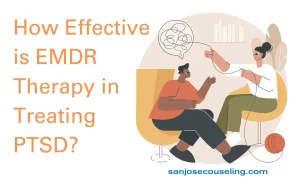Eye Movement Desensitization and Reprocessing (EMDR) is a psychotherapy technique that involves bilateral stimulation to process traumatic memories, distressful emotions, stress, anxiety, or physical responses associated with emotional wounds.
If you've experienced trauma and are struggling to move forward, EMDR therapy could be a powerful tool for healing. Reach out to Dr. Invia A. Betjoseph, who is a Licensed Marriage and Family Therapist and a Certified Sex Addiction Therapist trained in EMDR, specializing in sex addictions, couples therapy, and trauma.
Call us at (408) 809-1063 today or Book A Free Video Consultation to dial down your traumatic experiences.
This article discusses 8 Phases of EMDR healing Therapy, Post-Traumatic Stress Disorder (PTSD), and the effectiveness of EMDR in treating PTSD.
Post-traumatic stress disorder is a condition that develops after an individual experiences a life-threatening or traumatic event. Such an event can make individuals feel scared, anxious, sad, and frightened if the shock remains lingering. Individuals with PTSD typically steer clear of any activity, situation, or individual that triggers memories of their trauma. Some common symptoms of PTSD are irritability, expression of unusual anger, difficulty sleeping, high-speed driving, sexual promiscuity, and alcohol or drug use.

The World Health Organization (WHO) and the American
Psychological Association (APA) recognize EMDR as an effective therapy for treating and reducing PTSD symptoms.
PTSD involves traumatic memories stuck in a neurological loop causing distress. EMDR works best on these neurological associations/loops of the traumatic memory. What makes EMDR different from other treatments is that it uses DAS (Dual Attention Stimulation) or BLS (Bilateral Stimulation), in which the patient focuses on traumatic memories and emotions while engaging in rhythmic stimulation with the EMDR therapist. The use of BLS simply desensitizes the distressing content of your targeted memory, leading to a gradual fading of PTSD symptoms.
The roles of EMDR in healing PTSD are as follows:
EMDR therapy has earned recognition in San Jose as a safe and effective treatment for trauma-related memories and emotions. Despite its proven success, it has faced skepticism and controversy.
Critics often raise concerns about its effectiveness and the lack of a clear mechanism, especially since therapists may vary in their implementation of the treatment. The technique involves rhythmic eye movements to process emotions and memories, which skeptics may question.
Some argue that the eye movement element is not crucial for successful treatment, while others emphasize its significance in addressing trauma and PTSD. Many debate that it uses a placebo effect, meaning you just start feeling better from a treatment without a medicine.
However, EMDR is a structured therapy and has a high success rate of treating emotional distress. If you want to have EMDR in San Jose, find a qualified EMDR therapist who can better explain the entire process and treat your emotional wounds
The cost of EMDR therapy in San Jose can vary depending on the therapist's experience, specialized EMDR certifications and training, session length, location, and insurance coverage.
However, the average cost of EMDR therapy may range between $150 and $280 per session. An average session can last for 45-90 minutes.
The qualified therapists list their experience, certifications, fee information, contact number, and email address on their social profiles at Psychology Today or on their EMDR therapy website.
EMDR can be effective for people dealing with trauma (PTSD), stress, anxiety, depression and other disorders. Individuals who struggle to process emotions and exhibit signs of trauma during the procedure are advised to abstain from pursuing EMDR.
A professional mental health expert may consider several factors to determine the right candidate for this therapy treatment, such as the patient's situation, history, and mental health. Those who cannot get treated through EMDR can opt for CBT, DBT, and Exposure therapy after consulting with their clinician. The following population needs to avoid eye movement desensitization and reprocessing therapy:
● Epilepsy patients
● Patients with severe mental illness
● People with unmanaged emotions
● People who experience hallucinations or delusions.

Dr. Invia A. Betjoseph is a licensed Marriage and Family Therapist, MFC 44618.
As a Psychotherapist, and a Certified Sex Addiction Therapist, he provides Psychotherapy, or Counseling and Sex Addiction Treatment for Sexual Addiction and Pornography or Porn Addiction.
© 2024 San Jose Counseling, Inc.
All Rights Reserved.